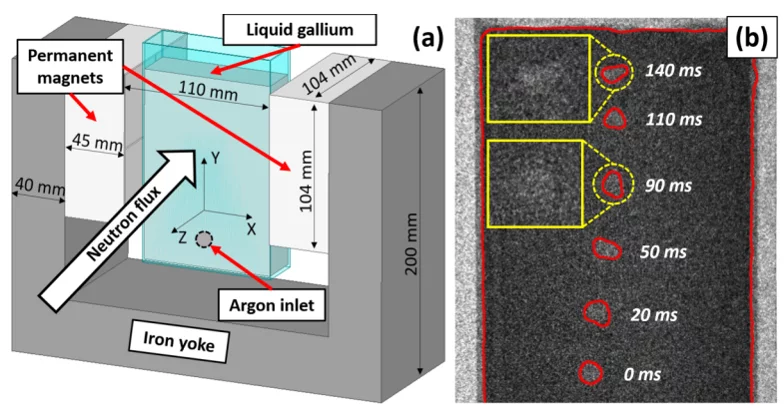The properties of metallic products depend crucially on their composition, microstructure and purity. In many technologies in which metals or semiconductors are processed in the liquid state, flow and transport processes have a decisive influence on the final product. Post-mortem analysis has proved to be inadequate to reveal the complex interrelationship between fluid flow and product quality or process efficiency and stability.
The (high temporal resolution) neutron imaging proves to be indispensable for obtaining a better understanding of highly complex turbulent flows (under applied external magnetic fields) and their influence on the integration/rejection of inclusions in and the solidification of the liquid metals. In the recent publication [1], we have demonstrated the bubble shape parameter variations captured via dynamic NR. The bubble shape parameters were successfully extracted from inherently low SNR images, while the investigated liquid metal layers were substantially thick (i.e., representative of industrial applications). As such, our approach shows potential to significantly expand the range of gas/liquid metal systems that can be studied using experimental setups downscaled via similarity criteria.
Publications
1. Birjukovs M., Dzemle V., Jakovičs A., Thomsen K., Trtik P., Phys. Rev. Fluids (2020)
2. Ščepanskis M., Sarma M., Vontobel P., Trtik P., Thomsen K., Jakovičs A., Beinerts T. (2017)
3. Lappan T., Sarma M., Heitkam S., Mannes D., Trtik P., Shevchenko N., Eckert K., Eckert S., Metals & Mater. Ser. (2021)
Collaboration
- Group of Prof. Dr. A. Jakovičs, University of Latvia, Riga, Latvia (Mr Michael Birjukovs)
Contact
Dr. Knud Thomsen, knud.thomsen@psi.ch +41 56 310 4210 Assoc. Prof. Dr. P. Trtik, pavel.trtik@psi.ch, +41 56 310 5579


